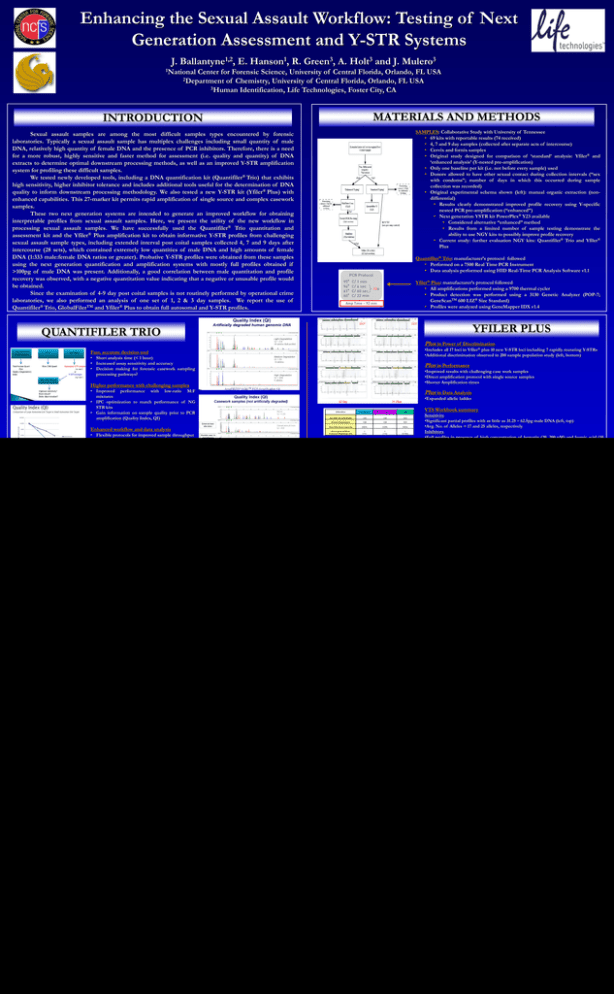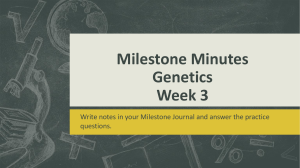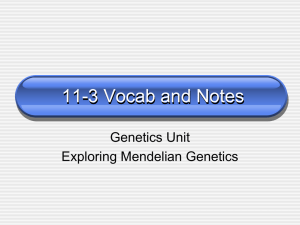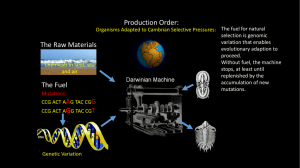
Enhancing the Sexual Assault Workflow: Testing of Next
Generation Assessment and Y-STR Systems
J. Ballantyne1,2, E. Hanson1, R. Green3, A. Holt3 and J. Mulero3
1National
Center for Forensic Science, University of Central Florida, Orlando, FL USA
2Department of Chemistry, University of Central Florida, Orlando, FL USA
3Human Identification, Life Technologies, Foster City, CA
MATERIALS AND METHODS
INTRODUCTION
SAMPLES: Collaborative Study with University of Tennessee
• 69 kits with reportable results (74 received)
• 4, 7 and 9 day samples (collected after separate acts of intercourse)
• Cervix and fornix samples
• Original study designed for comparison of ‘standard’ analysis: Yfiler® and
‘enhanced analysis’ (Y-nested pre-amplification)
• Only one baseline per kit (i.e. not before every sample) used
• Donors allowed to have other sexual contact during collection intervals (“sex
with condoms”; number of days in which this occurred during sample
collection was recorded)
• Original experimental schema shown (left): manual organic extraction (nondifferential)
• Results clearly demonstrated improved profile recovery using Y-specific
nested PCR pre-amplification (“enhanced”)
• Next generation YSTR kit PowerPlex® Y23 available
• Considered alternative “enhanced” method
• Results from a limited number of sample testing demonstrate the
ability to use NGY kits to possibly improve profile recovery
• Current study: further evaluation NGY kits: Quantifiler® Trio and Yfiler®
Plus
Sexual assault samples are among the most difficult samples types encountered by forensic
laboratories. Typically a sexual assault sample has multiplex challenges including small quantity of male
DNA, relatively high quantity of female DNA and the presence of PCR inhibitors. Therefore, there is a need
for a more robust, highly sensitive and faster method for assessment (i.e. quality and quantity) of DNA
extracts to determine optimal downstream processing methods, as well as an improved Y-STR amplification
system for profiling these difficult samples.
We tested newly developed tools, including a DNA quantification kit (Quantifiler® Trio) that exhibits
high sensitivity, higher inhibitor tolerance and includes additional tools useful for the determination of DNA
quality to inform downstream processing methodology. We also tested a new Y-STR kit (Yfiler® Plus) with
enhanced capabilities. This 27-marker kit permits rapid amplification of single source and complex casework
samples.
All samples
regardless of quant
These two next generation systems are intended to generate an improved
workflow amplified
for obtaining
value
interpretable profiles from sexual assault samples. Here, we present the utility
of the new workflow in
1ng
target
if possible and
® Trio
processing sexual assault samples. We have successfully used the Quantifiler
quantitation
volume
(10 l) used if 1ng not possible
assessment kit and the Yfiler® Plus amplification kit to obtain informative Y-STRMaximum
profiles from
challenging
Standard
sexual assault sample types, including extended interval post coital samples collected
4, 7 30
andcycles
9 days after
Product
detection
on 3130
intercourse (28 sets), which contained extremely low quantities of male DNA and
high amounts
of female
POP-7;from
16 sec
inj samples
time; 50 RFU threshold
DNA (1:333 male:female DNA ratios or greater). Probative Y-STR profiles were obtained
these
standardobtained
inj time for
using the next generation quantification and amplification systems with mostly Used
full profiles
if our instrument
later to reduce to 10 sec inj
>100pg of male DNA was present. Additionally, a good correlation between male Suggested
quantitation
and profile
Samples already processed using 16 sec inj
recovery was observed, with a negative quantitation value indicating that a negative or unusable profile would
be obtained.
Since the examination of 4-9 day post coital samples is not routinely performed by operational crime
laboratories, we also performed an analysis of one set of 1, 2 & 3 day samples. We report the use of
Quantifiler® Trio, GlobalFilerTM and Yfiler® Plus to obtain full autosomal and Y-STR profiles.
Quantifiler® Trio: manufacturer’s protocol followed
• Performed on a 7500 Real Time PCR Instrument
• Data analysis performed using HID Real-Time PCR Analysis Software v1.1
Yfiler® Plus: manufacturer’s protocol followed
• All amplifications performed using a 9700 thermal cycler
• Product detection was performed using a 3130 Genetic Analyzer (POP-7;
GeneScanTM 600 LIZ® Size Standard)
• Profiles were analyzed using GeneMapper IDX v1.4
52
25/27
QUANTIFILER TRIO
YFILER PLUS
23/27
Plus in Power of
•Includes all 17 loci in Yfiler® plus 10 new Y-STR loci including 7 rapidly mutating Y-STRs
•Additional discrimination observed in 200 sample population study (left, bottom)
Fast, accurate decision tool
• Short analysis time (< 1 hour)
• Increased assay sensitivity and accuracy
• Decision making for forensic casework sampling
processing pathways?
Plus in Performance
•Improved results with challenging case work samples
•Direct amplification protocol with single source samples
•Shorter Amplification times
Higher performance with challenging samples
• Improved performance with low-ratio M:F
mixtures
• IPC optimization to match performance of NG
STR kits
• Gain information on sample quality prior to PCR
amplification (Quality Index, QI)
100.0000
Plus in Data Analysis
62.5pg
31.25pg
DNA Quantity (ng/uL) by Target
Small Autosomal
Large Autosomal
0.0100
0.0010
0.0001
Ctrl
Low
Med
Hi
DNA Degradation Condition
•Difference between the two targets assists users in identifying possible degradation
•Expanded allelic ladder
Sensitivity
•Significant partial profiles with as little as 31.25 – 62.5pg male DNA (left, top)
•Avg. No. of Alleles = 17 and 25 alleles, respectively
Inhibitors
•Full profiles in presence of high concentration of hematin (20, 200 mM) and humic acid (10,
100 ng/ml)
•Yfiler® inhibited (no male profiles) at higher conc.
Mixtures
•Full male profiles in 1:1000 and 1:4000 male/female mixtures
•Minor male profiles detected in 1:8 male:male mixtures
Enhanced workflow and data analysis
0.1000
38
VTS Workbook summary
10.0000
1.0000
Discrimination
• Flexible protocols for improved sample throughput
• Improved consistency and homogeneity of DNA
standard
• Customized workflow templates plus data analysis
and STR setup tools
29
EXTENDED INTERVAL POST COITAL SAMPLES (4-9 DAYS)
Total Yield – Male DNA (ng)
Average Total Male DNA Yield (pg)
Total Yield – Human DNA (ng)
F:M Ratio
•333:1 to 4,685,117:1
•AutoSTR not possible
Quality
(Degradation) Index
Samples: 28 of 69 UTHSC kits (~40%)
~15 ml extracts; N= 28 kits (84 samples)
• Closer look at low range
•A few samples with higher quants
•5 samples > 1ng (1, 2, 2, 6, 18 ng)
Input Male (ng)
Yfiler® Plus
Averages by time interval
•Greater male DNA recovery in 4 day
samples (as expected)
•Large variation
Based on T. Small Autosomal Values
•~0.5 – 16 mg
•Most > 2 mg
4-day
26/27
27/27
27/27
•No evidence of significant
degradation
•Is sperm DNA quality
masked?
7-day
27/27
0/27
9-day
1/27
• Wide range of input
• Up to 1ng
4-day
7-day
9-day
61% with >6 alleles
29% with >6 alleles
39% with >6 alleles
50% with >11 alleles
22% with >11 alleles
25% with >11 alleles
39% with >21 alleles
18% with >21 alleles
22% with >21 alleles
Yfiler® Plus Profiling Success Rate
Input Human DNA
(ng) – Yfiler ® Plus
•Percentage of29%full
profiles
for each
interval
with >6
alleles
with >6 alleles
Number
of39%
Alleles
50% with >11 alleles
22% with >11 alleles
25% with >11 alleles
•Significant % of probative profiles (>16 alleles)
39% with >21 alleles
18% with >21 alleles
22% with >21 alleles
4 day – 46%
7 day – 22%
9 day – 22%
61% with >6 alleles
• Majority with > 1mg
2719ng total in amp; M/F 1: 5,056
2001ng
total
in amp;
1: 21,209
1793ng
total in
amp;
M/F 1:M/F
31,015
59
1921ng
11,321
1730ngtotal
totalininamp;
amp;M/F
M/F1:
1:1,785,058
60
57
3824ng total in amp; M/F 1: 1,291,698
No. of Alleles vs. Total Male DNA (pg) in Amp
(Low range shown)
•
61
Number of Alleles
57
• More alleles as input increases
More or less complete profiles (>24 loci) with 100pg
male DNA
1-3 DAY POST COITAL SAMPLES: AUSOTOMSAL AND YSTR PROFILING
Accuracy of profiles confirmed by comparison to reference profiles
• In addition to the extended interval samples (4-9 days), we also wanted to evaluate
more routinely encountered intervals: 1, 2 and 3 days
• Differential extraction (manual organic)
• Samples quantitated with Quantifiler® Trio
• No degradation
• Decision making: GlobalFilerTM (autosomal STRs) or Yfiler® Plus (Y-STRs) (top
panel)
• All samples amplified with both kits to determine if “predictions” or “decisions”
were good (bottom panel)
• Observed results consistent with information gained from Quantifiler® Trio
• GlobalFilerTM (Autosomal STRs) – top panel
•
•
•
•
Non-sperm fractions (NSP): female profile only
1 day sperm fraction (SP): M/F mixture, major male, very minor female profile
2 day sperm fraction: M/F mixture (~1:1)
3 day sperm fraction: no profile (no male quant; extremely low level human quant value ~0)
• Yfiler® Plus (Y-STRs) – bottom panel
• Full male profiles in 1 day and 2 day sperm fractions (also 1 day NSP)
• No male profile in 3 day sperm (no male quant, so negative quant = no result)
CONCLUSIONS
1. Quantifiler® Trio
•
•
Excellent correlation between male quantitation and profile recovery
Negative quantitation means negative/unusable Yfiler® Plus
2. Quality Index
•
•
Told us something about our samples (no degradation)
Male component “masked” in non-differential extracts; may not completely indicate quality of male DNA component
3. Yfiler® Plus
•
•
•
If >100pg male DNA, mostly full profiles
Results obtained even with extremely high quantities of background female DNA
Many ‘usable’ profiles with F/M ratios ranging from 333:1 to 100,000:1
GlobalFilerTM 1 day Non-sperm
Full female profile
GlobalFilerTM 1 day Sperm
Full male profile
Minor partial female profile
Yfiler® Plus 1 day Sperm
Full male profile
ACKNOWLEDGEMENTS
Portions of this work were supported by Award # 2009-DN-BX-0023, awarded by the National
Institute of Justice, Office of Justice Programs, U.S. Department of Justice. The opinions,
findings and conclusions or recommendations expressed in this presentation are those of the
authors and do no necessarily reflect those of the Department of Justice. We would like to
acknowledge Pat Speck and the UTHSC team.
We would also like to acknowledge the Life Technologies team: Jonathan Tabak, Andrea
Carbonaro, Sheri Olson, Jeff Sailus, Joanne Sgueglia, Lisa Calandro, Ariana Wheaton, Melissa
(a.k.a. Missy) Kotkin, and Shelly Guerrero.
We would also like to acknowledge members of the NCFS staff: Hayley O’Brien and Kelsey
Neary for their assistance with population data and data review.










